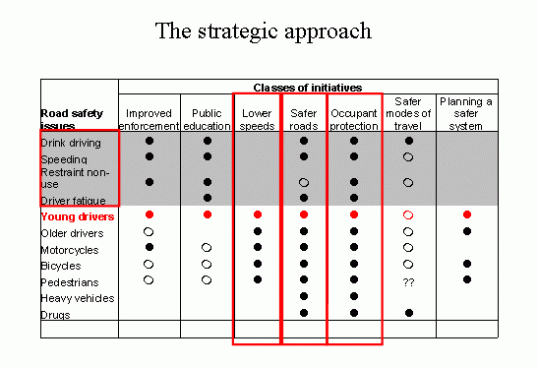Countermeasures
- Age of access
- Content of training: Best practice
- ITS
- Licensing regimes
- Specific post licence measures for novice drivers
- The Driver Test
- The need for early education
- Training Method
Countermeasures
Introduction
A variety of measures is available which specifically target on the increased accident risk among novice drivers, including changes in their exposure to driving.
Due to its multi-faceted nature, there is no single solution to this problem. Therefore, a package of countermeasures is required in order to combat it. Furthermore, as OECD and ECMT countries widely differ in culture, history, motorization and overall traffic safety levels, the strategies employed will need to be different for each set of circumstances.
This section gives an overview of the countermeasures used in different countries that can have an important impact on reducing young novice driver risk. These countermeasures are associated with age of access, driver training and testing, enforcement and communication.
Before turning to these countermeasures, we will first discuss some introductory issues related to these countermeasures:
Novice versus young drivers
A central issue in the process of selecting countermeasures is the question whether countermeasures should target only young drivers or all novice drivers? The answer to this question is primarily based on the following practical considerations. As all young drivers are initially novice drivers, in terms of countermeasures it is most effective to target the combined factors of age and inexperience-related phenomena. Moreover, in most industrialized countries, novice drivers tend to be fairly young. At the same time, many of the countermeasures that will be proposed are equally applicable to all novice drivers, whatever their age.
Exposure control versus safe travelling
Countermeasure effectiveness can be assessed for several different potential success criteria:
The 'absolute number criterion' aims solely to increase safety and may entail measures that reduce travel, or even block access to the traffic system as drivers by increasing the age at which novice drivers can gain their licence. In contrast, the 'risk criterion' states that safety should be expressed as a decrease in fatalities/crashes per distance driven.
These two different perspectives result in different assessments of the outcome of measures, as well as in preferred measures. They also show that individual measures are effective in two distinct ways:
The contribution of general safety measures
It is important to recognise that young drivers benefit from general traffic safety measures such as adequate traffic regulations (like low BAC), good quality enforcement of rules and regulations, safe roads, injury protection systems etc. Table 1 gives a survey of general measures that are particularly effective for young drivers.
Table 1: Survey of generic measures benificial to specific road safety issues, by type of effect (unfilled circles = indirect effect/filled circles = direct effect) (Western Australia Road Safety Council and Government (2002)
Contribution of non-road safety policies
Non-road safety policies, such as the existence of an effective public transport system with reduced fares for young users can have an important impact in changing young novice drivers' patterns, mileage and risks. Other examples of how overall policies may affect young driver safety are geographical location of youngsters' meeting points like discos and socially safe transport. This kind of policy may encourage youngsters to drive or even drink and drive. Similarly, such non-road safety policies may also reduce exposure. In the Netherlands for example, the introduction of a free public transport pass for students has systematically and enduringly reduced mileage in the age group 18-24 yrs, and subsequently reduced their accident rate.

